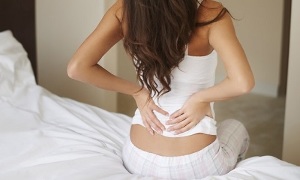
Low back pain is a symptom that can be associated with various medical conditions. They can be permanent or periodic, local or generalized.
If a person has pain in the lumbar spine, a comprehensive examination is prescribed to identify the cause.
Possible causes of low back pain and its characteristics
Back pain can be caused by several reasons, depending on which the intensity of the discomfort varies. Pain syndrome reduces a person's quality of life, limits mobility and makes it impossible to perform daily tasks.
There are many causes of back pain in the lower back. Some of them are quite serious and require immediate intervention by a specialist.
Lumbar sciatica
Lumbar sciatica is a disease of the musculoskeletal system, in which compression and inflammation of the spinal roots occurs. This pathology is secondary in nature, as it develops in the context of degenerative processes of the musculoskeletal system.
The common symptoms in this case are:
- Pain syndrome, aggravated by sudden movements, weight lifting. The location of the pain depends on the degree of damage. The syndrome can affect the lumbar and gluteal regions, the back or front of the thigh. If there is damage to the nerve endings located under the first and second lumbar discs, the patient has low back pain in the lower back and the buttocks.
- Increased pain intensity when coughing, sneezing.
- Inability to stay in the same position for a long time.
- Mobility disorders: inability to freely tilt the trunk forward, backward or sideways, inability to bend the fingers of the lower extremities.
In radiculitis of the lumbar spine, the pain usually appears suddenly, to spontaneously. The next time, the pain becomes more acute, pronounced.
Osteoporosis
Osteoporosis of the spine is a phenomenon in which there is a process of leaching of calcium from the bones and interruption of the activity of the cells responsible for bone growth. Under such conditions, the bones are quickly destroyed and their density constantly decreases. Osteoporosis is difficult to suspect in the early stages of development.
Most of the time, the patient feels acute pain in the lower back at the moment of strong tension - with a sudden turn of the body, falling, weight lifting.
In addition to severe low back pain, osteoporosis has manifestations such as:
- chronic fatigue;
- abdominal bulge;
- impaired spine mobility.
In compression fractures caused by osteoporosis of the lumbar spine, acute pain occurs, which increases with palpation of the affected area, as well as muscle spasm.
Scoliosis
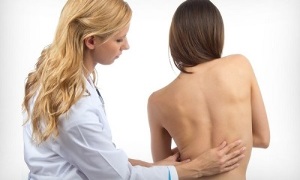
In scoliosis of the lumbar spine, its structures deviate to the right or to the left. These changes are reflected in the state of the surrounding tissues: they become irritated, foci of inflammation appear in the muscle-ligament structures.
Scoliosis on the left side is most often diagnosed. In left-handed people, scoliosis develops on the right side.
In the initial stage, lumbar scoliosis may not appear at all. Negative changes can be tracked only by the results of the X-ray examination.
The characteristic symptoms in this case, in addition to the severe pain in the lumbar spine, are:
- slouch;
- edema in the lumbar region;
- chest pain;
- displacement of the pelvic girdle, due to which one lower limb is shorter in relation to the other;
- slide divergence.
Characteristic aspects of pain in scoliosis of the lumbar spine: its appearance at the beginning of physical activity, decreased intensity of discomfort when walking. The pain is usually short-lived.
Injury
Lumbar contusions occur during falls, blows. The lower back is more susceptible to trauma.
Lumbar spine contusions are closed lesions in the tissues and part of the spine that do not cause anatomical abnormalities. This type of injury often occurs in athletes, as well as in people who work in the workplace.
When injured, the following additional symptoms are observed:
- hematoma formation;
- redness of the skin;
- increased pain when pressing on the injury site.
If the contusion is severe, the conduction of nerve impulses in certain areas of the lumbar spine can be disturbed, in some cases, complete loss of sensation.
Symptoms are most pronounced for low back injuries and include the following:
- pain when probing the affected area;
- growing hematoma;
- pain when turning the body, inability to bend;
- swelling in the ankle area, which indicates poor circulation;
- paralysis and paresis of the lower limbs.
Rheumatoid Arthritis
Rheumatoid arthritis of the spine is another likely cause of low back pain. In this case, the joints located in this area are affected.
Rheumatoid arthritis pain occurs most often at night, usually at dawn. In the initial stage, the syndrome can be suppressed with the help of special exercises, but at night the pain reappears.
Other symptoms: increased local temperature over the affected area, accumulation of fluid in the cavities of the affected joint.
Osteochondrosis
Osteochondrosis is a pathological process in which the intervertebral discs lose their elasticity. As the disease progresses, fissures and hernias form.
In the early stage of osteochondrosis, low back pain occurs rarely and does not differ in intensity. In the future, they acquire an accentuated chronic character. The patient feels rigid movements, constant fatigue. Difficulty in bending and extending the back.
Pain usually radiates to the lower extremities. At the same time, tingling and numbness occur.
Strengthening the intensity of unpleasant sensations occurs with increased physical activity, making sudden movements, lifting weights.
Malignant tumors
If your back hurts in your lower back, it can be associated with a dangerous pathology like cancer. In this case, a malignant tumor does not necessarily affect the bone structures of the spine. In this case, the pancreas, which is located behind the stomach, can be affected, so the pain can be attributed to the lower back. Severe pain indicates advanced stages of cancer.
In addition, pain in the lower back may be associated with the fact that tumors in other organs have metastasized to the indicated area.
In women, back pain can be a sign of the development of ovarian cancer. In men, acute and prolonged spasms indicate a prostate tumor.
Gynecological diseases
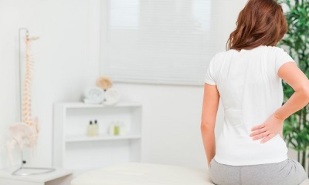
Women tend to worry about low back pain. A similar symptom can occur under the influence of pathologies such as:
- rupture of ovarian tissue;
- pathological processes of the uterus;
- cysts on the ovaries;
- cervical cancer;
- inflammatory processes of the fallopian tubes;
- benign formations on the inner wall of the uterus.
Low back pain usually occurs in women who have had their pregnancy artificially terminated. Unpleasant sensations are caused by mechanical damage to the tissues of the uterus and the prolonged process of tightening the wound.
In women with gynecological diseases, pain in the lower back, pulling, pain. In addition, there is a violation of the menstrual cycle, loss of strength, irritability and increased body temperature. Often, the pain syndrome is supplemented by secretions of various consistencies and colors from the vagina.
The pain syndrome, in this case, is caused by hormonal imbalance and inflammatory processes that spread to the tissues of the lower back.
Kidney disease
Pain in the lower back of the waist is a clear sign of kidney disease.
A similar symptom accompanies pathologies such as:
- urolithiasis; pyelonephritis;
- glomerulonephritis;
- nephroptosis (prolapse of the kidneys).
In the presence of stones in the urinary tract, the pain in the lower back is not very pronounced, it has a dull character. With inflammatory processes that involve the kidneys, the pain is painful and constant. The location of its location, in this case, is on the left and right of the spine.
Acute pain is indicative of renal colic. The pain radiates to the groin area, inner thigh and anterior abdominal wall.
Additional manifestations that may indicate kidney disease include:
- increased blood pressure;
- swelling of the arms, legs, face that appears on waking and disappears during the day;
- change in urination: the process can be fast and painful or, conversely, rare, until complete cessation;
- lethargy;
- increased sweating;
- impaired appetite.
Discomfort and pain in the lower back are often associated with the fact that the fetus presses the kidneys in pregnant women. In this case, the painful syndrome is not associated with any pathology, it is a totally natural phenomenon.
Diseases of the genitourinary system in men
In strong sex, low back pain usually occurs with diseases of the genitourinary system. Most of the time, the discomfort is caused by prostatitis, an inflammatory process of the prostate. With this disease, the urination process and sexual function are interrupted. In addition to low back pain, there are pains in the lower abdomen.
Another male disease that contributes to the appearance of pain in the lower back is epididymitis, an inflammation of the epididymis.
Lumbar myositis
Lumbar myositis is an inflammatory process of muscle tissue, manifested by pain and weakness in the muscles, sometimes in their atrophy. The disease can be caused by infectious processes, trauma, hypothermia, metabolic disorders of the body.
This pathology is characterized by:
- sore pain in the lower back that worsens with movement;
- feeling of monotonous weakness in the muscles;
- swelling, redness of the skin.
Bone tuberculosis

In tuberculosis of the spine, the lower back usually hurts. The nature of the painful syndrome, in this case, depends on how many vertebrae are involved in the pathological process, as well as the degree of deformation of the structures.
The main signs of spinal tuberculosis are:
- Severe pain in the lower back. This location is associated with the fact that the lower back is the largest part of the spine, which receives the maximum loads.
- Increased sweating at night.
- Increase in the size of the lymph nodes.
- Increase in temperature by 37, 1-37, 3 degrees.
- Constant fatigue.
With the progression of tuberculosis of the spine, there is an angular curvature of this structure, with abscesses in the lumbar and thoracic region.
Climax
Weakening of sexual function in women is often accompanied by back pain. A similar phenomenon is associated with decreased ovarian activity, which is reflected in the level of the hormone estrogen. In conditions of its deficiency, bone tissue becomes more fragile and subject to damage.
In the context of hormonal changes, the musculoskeletal system as a whole becomes vulnerable: the intervertebral cartilage and discs become weaker, muscles and ligaments lose elasticity. As a result, the lower back, which always experiences the greatest stress, is particularly at risk.
In addition to containing pain, women during menopause suffer from headaches, excessive sweating and hot flashes.
Vascular pathology
The violation of blood circulation, caused by pathological vascular processes, can also cause pain in the lower back. Thrombophlebitis, atherosclerosis, phlebothrombosis contribute to the onset of pain syndrome.
The appearance of blood clots in the veins, inflammation of the vascular walls, narrowing of the vascular lumen - all this prevents the total flow of blood and therefore limits the supply of oxygen to the tissues and structures of the body, which negatively affects itscondition.
Additional symptoms that accompany vascular diseases are swelling of the veins, heaviness in the extremities and bluish color of the skin.
Intestinal diseases
With intestinal diseases, the pain can radiate to the lower back. This is due to the fact that the intestinal tract occupies a significant space in the abdominal cavity. If any part of it undergoes pathological changes, it grows, putting pressure on other organs. The spine is also at risk.
Pain extends to the lower back in ulcerative colitis, exacerbation of appendicitis, intestinal obstruction, irritable bowel syndrome.
In the case of pathological processes that spread to the stomach, the pain is located in the upper part of the lower back. Appear after meals, with the appearance of feeling hungry, in case of abuse of harmful products.
The following symptoms are seen in parallel:
- flatulence;
- fecal disorders;
- abdominal pain.
Obesity
Excess weight puts additional pressure on the spine, especially the lumbar spine. The constant pressure creates the risk of developing pathologies of the musculoskeletal system, causes injuries to the intervertebral discs, curvature of the spine and the development of osteochondrosis.
In addition to the pathological reasons above, pain in the lower back can occur due to prolonged driving or computer time, excessive loads at the gym, hobbies for working in summer cottages and a sedentary lifestyle.
Which doctor should I consult?
The onset of low back pain is often caused by serious disorders in the body, so it is important to consult a doctor in a timely manner to diagnose the real cause and treat it.
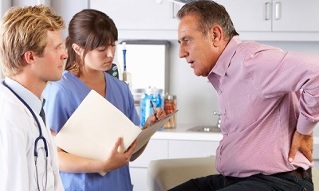
It is necessary to consult a specialist if the patient has pain in the lower back:
- is regular;
- appears constantly after physical effort;
- does not disappear when lying down;
- is accompanied by numbness of the limbs and increased body temperature.
The main specialists you should contact if you have back pain in your lower back are:
- vertebrologist (treats osteochondrosis and other neurological diseases); neurologist
- ;
- nephrologist (urologist): this specialist diagnoses and treats whether low back pain is associated with pathological processes in the genitourinary system.
If necessary, other specialists are involved in the diagnosis and treatment process: an orthopedist, surgeon, gynecologist, oncologist and gastroenterologist.
Diagnosis
For pain in the lower back, the following diagnostic measures are prescribed:
- general examination, identification of anamnesis;
- test to determine the contained nerve endings;
- blood test to assess hemoglobin level; myelography;
- X-ray examination of the spine;
- MRI;
- CT;
- ultrasound of Organs abdominal organs;
- endoscopy of the uterus, stomach, intestines;
- bone scintigraphy.
The activities listed allow you to compile a complete picture of the patient's condition, identify the disease causing pain in the lumbar spine and also determine an appropriate course of treatment.
Approaches for the treatment of low back pain
The main course of treatment for low back pain depends on the cause of the symptom. The therapy aims to eliminate the existing disease.
General principles
Treatment is based on the following:
- the use of drugs to suppress inflammatory processes;
- performing physiotherapy procedures in order to accelerate the recovery of the affected structures;
- physiotherapy exercises.
In the treatment process, the patient should avoid active sports activities, as well as any physical activity, so as not to aggravate the course of the pathological process. During the rehabilitation period, the patient may be advised to practice yoga, swimming and walking outdoors.
In addition, therapy includes dietary correction. The patient must refuse heavy food, all greasy and fried. It is important to give up bad habits - this will significantly speed up the healing process.
Medicines

For lower back pain, medications are usually prescribed in the form of injections, which include vitamin B. The tasks of these medications are:
- accelerating the restoration of damaged nerve fibers;
- increased functional activity of the central and peripheral nervous system;
- acceleration of metabolic processes.
For strong and intense low back pain, powerful analgesics are prescribed.
Nonsteroidal anti-inflammatory drugs that control inflammation are also administered by injection.
After a cycle of injections of non-steroidal anti-inflammatory drugs, drugs in this group are prescribed in the form of tablets for oral administration.
For muscle spasm that causes low back pain, medications such as muscle relaxants are prescribed.
Patients also receive external medications. They usually have a warming effect and help to suppress pain. They are prescribed only as part of a comprehensive treatment.
For lower back pain, special ointments are recommended.
Corrective Gymnastics
A series of therapeutic exercises is prescribed only after the reduction of the painful syndrome. During an exacerbation, therapeutic exercises are contraindicated.
For low back pain, the following exercises are recommended:
- Increases the pelvic region.You need to lie on your back and bend your legs at right angles. The pelvis should be lifted up smoothly and returned to its original position. Repeat 10-15 times.
- Maintain balance.The exercise is performed standing up. You need to stand on tiptoe and try to keep your balance in this position for about 10-15 seconds. Repeat 3-5 times.
- Lift your legs from the lying position.Lie on your back, alternately lift the stretched lower limbs as high as possible. Perform 5-10 lifts for each leg.
- Movement in the buttocks.You need to sit on the floor, straighten your back. Using your pelvis and buttocks, move forward and then back. You need to walk this way about 2 m forward and the same distance back. The number of approaches is 2-3.
You should not do gymnastics in case of spinal injuries, tumors and hernias, as well as in the presence of diseases that occur in an acute way.
Physiotherapy
Physiotherapy procedures are performed as long as low back pain is not caused by an acute inflammatory process. Acute pain syndrome is first relieved by conservative methods and only after physical therapy is prescribed.
For pain in the lower back, the following procedures are prescribed:
- Magnetotherapy.This method improves blood circulation in the affected area.
- Electrophoresis.This method is necessary if you want to speed up the release of medications for the injury (analgesics, nonsteroidal anti-inflammatory drugs, chondroprotectants).
- Laser therapy.The technique allows normalizing the metabolism and improving blood circulation in the affected areas.
Nutrition
To strengthen bone elements, you should include cottage cheese, dairy products and adequate whole milk, fatty sea fish and black bread in your diet.
If the patient is overweight, which creates an additional burden on the spine, it is necessary to exclude flour, sweets and sugary carbonated drinks from the diet.
Folk remedies
Traditional methods of treatment should in no way become the basis for the treatment of low back pain. They are exclusively an auxiliary method and are used only with the approval of the attending physician.
For back pain, you can use the following traditional medicine recipes:
- Honey-based ointment.To prepare a medicinal composition, you need to take 3 tablespoons of natural bee honey and melt in a water bath. Cool the composition. Add 2 tablespoons of pharmacy alcohol to the honey, add 100 g of petroleum jelly and rub in the areas where the pain is located. For greater effectiveness, you can apply a compress with this ointment. In this case, it is not rubbed onto the skin, but rather spread in a thin layer and placed on a cling film and wrapped with a warm tissue over it. Leave the compress for 3-4 hours and then wash the composition with warm water.
- Salt compress.It is necessary to dissolve table salt in hot water (proportions - 1: 10), stir. In the final solution, moisten a gauze cloth folded in several layers, cover the lumbar region with a compress, wrap in a towel and warm with a tissue. Go out at night, remove the rest of the compress in the morning.
- Garlic tablet.You need to take 3 heads of garlic, peel and mince. Pour the resulting batter with warm water (2 cups), leave for 3 hours. In the infusion, moisten a cotton cloth and sprinkle with freshly squeezed lemon juice across the surface. Apply cold compress. Leave for 20 minutes for a damp towel to reach body temperature. Then, repeat the compress application procedure. This can be repeated until the patient feels relief.
- Compress with a body.You need to mix the bodyagi powder with olive oil in a 1: 30 ratio. Lubricate the sore lower back with the resulting composition, leaving the product on the skin for 40 minutes. After the end of the specified period, the product must be washed with warm water.
- Compress dry burdock leaves.You need to moisten the raw material in boiling water, stick it on your back, wrap it with a warm tissue over it. Leave the compress for at least an hour.
- Baths with additives.Bathing can reduce the intensity of pain. As additives 200 g of mustard powder, 600 ml of broth with mint leaves can be used. Take a shower in 20 minutes. The water must be warm.
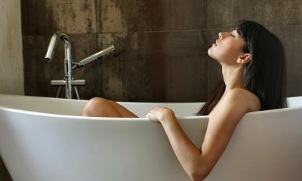
All treatments listed are aimed at relieving low back pain, that is, they are symptomatic.
The treatment of a specific diagnosed disease must be carried out according to a separate schedule.
Prevention
To reduce the risk of low back pain, you should:
- monitor your posture;
- stand and walk only with your back straight;
- perform special exercises to strengthen the spine and back muscles;
- do not expose the spine to excessive loads, exercise moderately using the back muscles;
- avoid hypothermia;
- as far as possible, practice a sport that does not negatively affect your spine: swimming, yoga, walking are especially helpful;
- do not make sudden movements when lifting loads;
- sleeping on a medium firm mattress, best of all - orthopedic, the pillow must also be orthopedic and of medium size;
- control weight, if necessary, follow a diet and do special exercises to combat extra pounds;
- ingesting vitamin and mineral complexes, especially during periods of hormonal changes in the body.
Back pain can be associated not only with diseases of the spine, but also with dysfunctions of internal organs. A specialist can determine the true cause of the pain syndrome during diagnostic measures. Both the symptom itself and its cause must be treated.

























